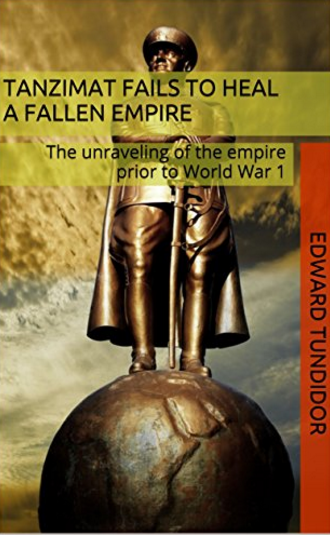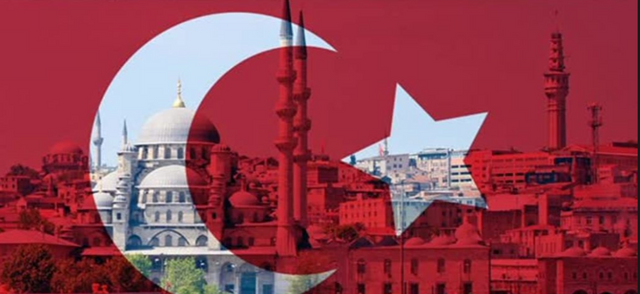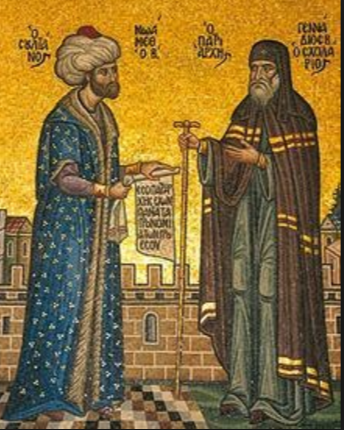(Book) - Tanzimat fails to heal a fallen Empire by Edward Tundidor - Part 2
This 3 part series is my book that uncovers the final years of the Ottoman Empire.

Check out part 1 - https://steemit.com/history/@elumni/book-tanzimat-fails-to-heal-a-fallen-empire-by-edward-tundidor-part-1
In part 2: Chapter 3 & 4
Table of Contents
• Chapter 1: Implementing the Tanzimat reforms
• Chapter 2: The economic and social construct of the empire
• Chapter 3: Western Education and Civil Rights in the Ottoman Empire
• Chapter 4: The decay of the empires power due to nationalism
• Chapter 5: Nationalism sparks revolution
• Chapter 6: The World War 1 genocide of the Armenian subjects
Chapter 3: Western Education and Civil Rights in the Ottoman Empire
In 1857, the Ottoman government began to rebrand their education system instituted by the Sultan, with a western perspective to modernize the Empire. Minorities had the opportunity to enroll in the Ottoman school founded in Paris, of those 35 minority students only four were able to assume roles in the Ottoman government. Furthermore, the educational system within the Ottoman Empire functioned under the banner of division as “minorities (ensuing from social closure)” did not gain access to administrative positions or enrollment to the new schools instituted by the Sultan at the same rate as their Muslim counterparts. The outward display of ethnic segmentation is in all facets of the political, and educational system further shows the Tanzimat has failed to reform relation of the Ottoman social structure. As an alternative to this discrimination, Western protective powers instituted Western-style education to all minority groups within the Ottoman Empire. The schools established by local opposition leaders and Western powers often taught their students at a much faster pace than their Muslim contemporaries. A persistent blockade was up against minorities keeping them from gaining entry into the Ottoman assembly, further establishing that Ottoman bureaucrats did not want the minority population to have a voice and political matters. Opposition delegates wanted to ratify religious designations from the political language and move towards identifying minority subjects simply as Ottomans. These discriminatory actions on the part of the Ottoman government towards its non-Muslim subjects helped form a new initiative rather than seeking equality, as these groups attempted to gain full autonomy from their oppressors. During this era of minimal political involvement, minorities started to demonstrate their administrative capabilities when they became influenced by revolutions in North America and France. Minorities within the Ottoman Empire desired within the social contract between them in their Muslim counterparts was the implementation of “civil rights”, and the protection of private property for all Ottoman subjects. Moreover, minorities began to make the Ottoman at government aware of their obligation to protect these freedoms, along with protecting the economic stability, particularly to those most vulnerable. Ottoman Muslims looked at Western education as a mechanism to reboot the Empire rather than a reforming device. Non-Muslims saw Western Education as a driving force towards putting a stop to the social boundaries that prevent the obligations of the Tanzimat reforms from coming to fruition. Western education essentially helped spawn the Young Turk movement based on principles of Islamic ideals, and non-Muslims took the influence of Western education and drove it towards political movements for independence and autonomy.

The nationalistic movement that was in its infancy in the mid-to-late 1800s continued into World War I, but the imprint of disputes that went on in the mid-to-late 19th century built the foundation for the bloodshed that was to come on the part of the Ottoman Turks towards their non-Muslim population. Christians exhibited plenty of nationalistic pride in Cretan during this period. In 1858 into the mid-1860s this group called for an end to the oppression caused by governor Ismail Pasha, they also sought for improvements to civil liberties and local institutions such as tribunals and banks although offered by provisions in the Hatt-I Humayun. Sultan Abdul-Mejid implemented These regulations to eliminate restrictions upon millets, which in the end became empty promises and millets stayed relatively the same. This new edict handed down by the Sultan was not received well by the Muslim populace as they were “opposed” to the edict as they felt it lacked Islamic principles. Christians call for more political equality in 1866 that led to the Christian revolt in Cretan. Cretan Christians requesting expedient processing of criminal and civil matters in court, which led the Sultan to make a reactionary move by “dispatching to Crete 2520 troops and four mountain howitzers” in an act of domination in totalitarianism against the Christians. After the overwhelming military intervention of the Ottoman government, by June 2 the region returned to its status quo, and the Christian population became silenced. The give-and-take actions of the Ottoman government regarding social reforms only ignited tensions further, from an ethnic-religious standpoint. Many Muslims in the region rejected their government persistently imposing Tanzimat reforms because they feel it further “exacerbated the relations between Muslims and Christians” which became to be the sentiment of Muslims throughout the Empire. Although the Ottoman government pushed the Tanzimat reforms to the dismay of the Ottoman subjects, the reforms did not have the lasting effects that it was originally intended to have on the social strata of the Empire during the mid-1860s. During this period, many nations in Central and Eastern Europe began to establish a nationalistic identity as well, which helped them gain the independence they desired. In the region of Lebanon and Cretan after the Christian revolt the initiative shifted to a directive toward nationalism, which is identified as “the Eastern question in the Balkans and beyond.” Entering the 1870s the lack of reform obligations that were not being met by the Ottoman government left European nations with the idea that the Empire would never “be raised to the status of a full civilized power” in an attempt to be on par with its European counterparts.
Chapter 4: The decay of the empires power due to nationalism
The Ottoman Empire was under immense pressure after the Crimean war, the cost Empire a loss of territory and a sizable portion of his population. Along with the loss of territory, the Ottoman Empire was feeling the pressure from its European counterparts from an economic and social standpoint. As the Tanzimat reforms continue to increase tension in the Empire, the loss of territory was not the deciding factor in the collapse of the Empire but rather “nationalism developed by the non-Muslim communities of the Empire” no longer wanted what the reforms promised, but rather wanted independence and liberty from the Ottoman Empire. French nationalism that occurred in the 19th century along with groups such as the Greeks and Italians gaining independence help spread the nationalistic view in the Ottoman Empire among various ethnic groups. The social issues coincided with economic problems as the Empire was engulfed in a continuous era of steady decline throughout the mid-to-late 19th century. The empires financial outlook took a nosedive when the public debt administration was authorized to access to a variety of essential revenue sources, further crippling the Ottomans and debasing their economy. As the world economy was improved in 1896, the Ottomans were powerless in capitalizing on economic opportunities because of their mishandling of their economic destiny. During this period of economic woes for the Ottoman Empire, the non-Muslim subjects were able to establish a lifestyle that was “relatively wealthy and well-educated” as they were able to take advantage of their control and access to markets, and their ability to be more responsive to Western education.

The Ottoman Empire had little success with the implementation of the Tanzimat reforms in the 19th century which caused much tension between the Empire and its European neighbors who protected minority groups in the Empire. The reforms indirectly as you developed nationalistic ideals in both its Muslim and non-Muslim subjects that infringed on the Sultan’s ability to rule leading into World War I. The nationalistic ideals built into the minority population was a product of the state’s traditional model of “Islamic orthodoxy” which was the foundation of the political construct that had “little saliency for either the wider international community” leaving the European powers little confidence in the Ottoman Empire going forward. Christian minorities also felt that Hatti’s provisions quelled opportunities of influencing administrative policy. Christian laymen were strongly pushing for administrative control of the millet system, but the compromise was for these Christians to serve in the military. However, to the behest of the Ottoman hierarchy minority groups protected by European powers were able to “evade the provisions of the new laws and the responsibility of citizens” forming the mindset within Ottoman authorities and intellectuals that minority subjects did not have nationalistic pride, and were not willing to shed blood for the Empire. Christians particularly Armenians were going through a cultural transition at this time as the founder of the Armenian cultural revival movement wanted the enlightened Armenian people to take these nationalistic principles and connect with the rest of Europe.
In contrast to the growing nationalistic ideologies forming in non-Muslim communities, the same type of nationalistic ideals formed in the young Turkish intellectuals who studied medicine and science in the new Western-style schools. These young Ottoman Turks started to rethink the formation of governance and policy as they were driven to “demolish, with our own hands, the tower of despotism eradicated” as they felt was the driving force for the prosperity and survival of the Ottoman Turks. These young Turks started to mobilize with like-minded individuals in a secret society that opposed the formation of government policy and social structure under the Tanzimat reforms headed by the Sultan. Many Muslims felt that reforms brought communal autonomy to its minority subjects, but their persistent requests for equality made groups such as the Young Turks feel that “European powers protecting Ottoman minorities “fostered on ideology of separateness,” leaving Ottoman Turks to believe they are undergoing an invasion from within. Additional provisions in the 1880s were made on the part of the European powers and the Ottoman government to allow protected Christians the option to become full citizens of Ottoman the Ottoman Empire or their European protector state. This proposal led to a sharp decline in the Christian populace within the Ottoman Empire from 40% of the total populace to 20% by the early 20th century. While the Empire saw a decline in its Christian populations, it also saw a dramatic influx of Muslim refugees into Istanbul as a consequence of the Russo-Turkish war of 1877 and 1878. The flow of refugees prompted Christian populations that occupied former Ottoman territories to vanquish Muslims as a form of “ethnic cleansing” to homogenize their society. Young Ottoman Turks were stunned by this new revelation as they had to share “the same political fate” as their uneducated Muslim refugee counterparts. All of these variables were contributing factors to the Young Turks administrating their constitutional revolution of July 1908 as a means to overthrow the sultan, and preserve Ottoman Turkish survival as a nation and political entity.
Part 3 coming tomorrow! Notes and Souces provided in Part 3
Tanzimat fails to heal a fallen Empire: Is available now on Amazon.com for $0.99 use this link for your purchase. ( Kindle format Only) http://amzn.to/2fVWZkS

If you enjoyed my work

All proceeds from upvotes on this post are going to more Steem Power.